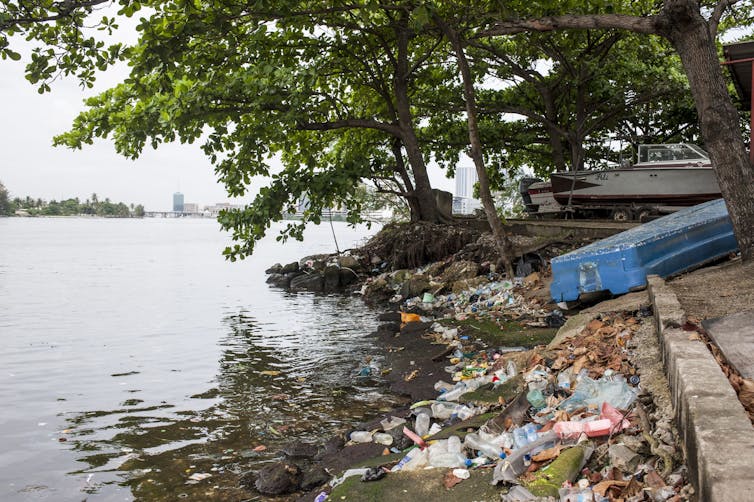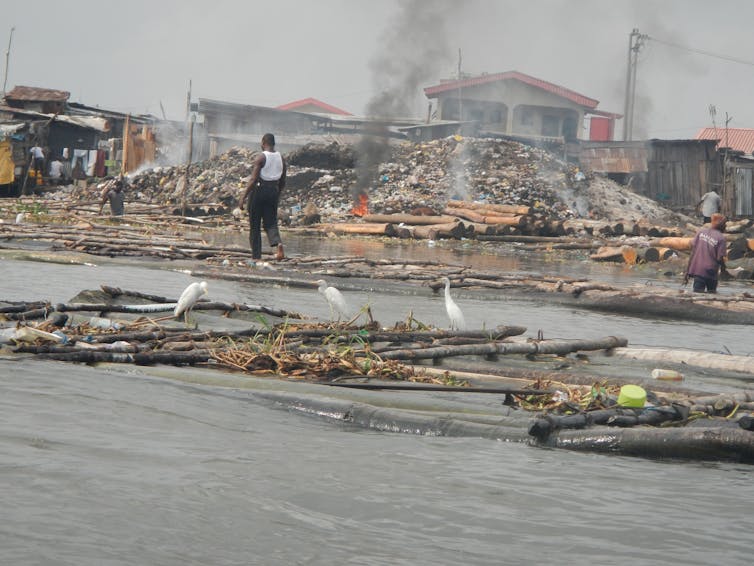How we learnt more about dangerous pollutants in Lagos lagoon

Lagos lagoon is the largest of four lagoon systems off the Gulf of Guinea. Several rivers and waterways empty into it, and it plays an important role in the West African coastal ecosystem as well as the Nigerian economy.
Several aquatic organisms in the lagoon are commercially important species, providing food and income for surrounding communities and beyond. The fish caught here represent more than half of Nigeria’s fisheries production of nearly 800,000 metric tonnes. This unique brackish water environment also plays significant roles in ecosystem stability and as a breeding ground for aquatic species.
Unfortunately, the lagoon receives enormous amounts of largely untreated industrial and other wastes. Lagos State accounts for most of the country’s industries and is home to an estimated 20 million people.
The Ogun, Osun, Ona and Yewa rivers empty large volumes of water from inland and coastal cities. This water is generally polluted by industrial, domestic and agricultural activities. The lagoon also receives a large quantity of pollutants from manufacturing and municipal activities in the greater Lagos metropolis. They include organic and inorganic pollutants which produce potential health risks for fish, shrimps and crabs – and people who eat them.
We conducted a study to evaluate the effects of these pollutants on fish food and the environmental health of the Lagos lagoon. We aimed to provide environmental health management authorities with scientific data for effective protection of marine ecosystems and human health. We used a novel method for analysing sediment samples, to understand how the different pollutants distribute within the lagoon ecosystem and affect the organisms that live there.
We found that the complex combination of pollutants in Lagos lagoon interferes with fish and mammal biology – especially their endocrine systems – and is potentially harmful to humans.

How we tested the effect of pollutants
The growth and industrialisation of big cities such as Lagos contribute many pollutants to water and land ecosystems. A number of pollution hotspots have also been identified in the area, including the city of Ikorodu, the slum area of Makoko and Idumota market. Plastic products, used tyres and car parts are some of the waste items that end up in the Lagos lagoon, through inappropriate waste disposal methods, dumping, and industrial and agricultural activities.
The end-station for these pollutants is the bottom of the lagoon. The sediments store pollutants and release them during heavy rainfall, winds and underwater turbulence. Bottom-dwelling organisms, particularly invertebrates, also stir up sediments during feeding and interactions between predators and prey, returning contaminants to the water.
In our study we tested three of the ways in which contaminants are released into the water in nature. This gave us a better understanding of how contaminants affect organisms in water.
The first method was elutriation, a process which simulates the natural process of mixing bottom soil and water, for example when boats disturb the water. In this process, pollutants are re-suspended in the water.
The second was polar extraction, which isolates pollutants that can dissolve in water and remain there in high concentrations.
The third was non-polar extraction. This method was used to evaluate the effects of pollutants that are transferred from sediment to organisms when they feed on particles of the bottom soil. Snails, earthworms, crabs and some fish can take in pollutants this way.
The different extraction methods produce results that are comparable to what happens in the natural environment. They allowed us to learn more about the complex interactions between water and bottom soil pollutants. We could also learn about the effects of pollutants on aquatic organisms, including the threat to their growth and reproduction.
We then exposed fish cells and rat cells to the pollutants extracted from the lagoon bottom soil.
Using animal cells (fish and rat) is a new way to avoid using live animals for research. It resolves the ethical dilemma associated with animal use in research and provides a deeper understanding of several biological processes. The molecular analysis of these cells can give an early warning of damage to animal and environmental health. Steps can then be taken to reduce harm.
What we found
Our assessment of contaminant loads at various parts of Lagos lagoon revealed a wide range of priority pollutants. These are pollutants with significant toxic potential for wildlife and humans. They include heavy metals such as mercury and cadmium, as well as organic compounds PCBs, phenols, PAHs and organotins. Some of these contaminants are known endocrine disrupting chemicals. They also induce enzyme systems that may alter the pollutant into a less harmful chemical and eliminate it from the body.
We reported that they produce hormonal imbalances with disruptive effects on the endocrine and chemical transformation systems of fish, crabs, shrimps and crocodiles. Such effects may lead to changes in reproductive organ development and result in gender confusion or the intersex condition. Documented effects on wildlife populations include reductions in fish species.
Our findings showed that exposing cells to low concentrations of the pollutants extracted from Lagos lagoon sediments not only killed the cells, but also activated the enzymes that metabolise these pollutants. Ultimately, this reduces the ability of the cell to break down pollutants properly, with further consequences for growth and reproduction.
Pollutants from industrial and domestic sources in the Lagos lagoon represent a cocktail of environmental contaminants. They are capable of interfering with the growth and reproduction of fish and mammals that depend on the stability of the lagoon ecosystem.
These findings imply that there are potential risks for harmful effects on human health. The pollutants are potentially transferred to humans from aquatic food resources. They become more concentrated along the food chain. Given that the hormone systems of vertebrates are similar, pollutants that affect fish will potentially affect humans in similar or comparable ways.
This indicates possible negative health consequences for people who depend on the lagoon as a food source.
The heavy pollutant load may also be contributing to the observed decrease in fish catches at the lagoon in recent times. This effect may arise from the inability of enough fish eggs and young fish to develop into adults. Or it could be from damage to food and nursery habitats for young fish.
What needs to happen
Until now, a lack of scientific information about pollution in the lagoon has made it difficult for regulatory bodies to develop and enforce water and food safety regulations. The information provided by our studies could contribute to developing protocols for treating industrial effluents. This is also in line with the United Nations Sustainable Development Goal 14, on the protection of life under water.
We recommend that regulatory agencies develop and adopt a Nigerian version of REACh (Registration, Evaluation, Authorisation and Restriction of Chemicals), the European Union Regulation 1907/2006/EC regarding chemicals. They should also do more to enforce the legal protection of natural habitats.
Government and industrial facilities should work together to find ways to reduce pollution before effluents reach the lagoon.
And finally, scientists need to routinely monitor the environment to see how species are responding.![]()
Aina Adeogun, Professor of Aquatic Toxicology, University of Ibadan
This article is republished from The Conversation under a Creative Commons license. Read the original article.









No comments:
Post a Comment